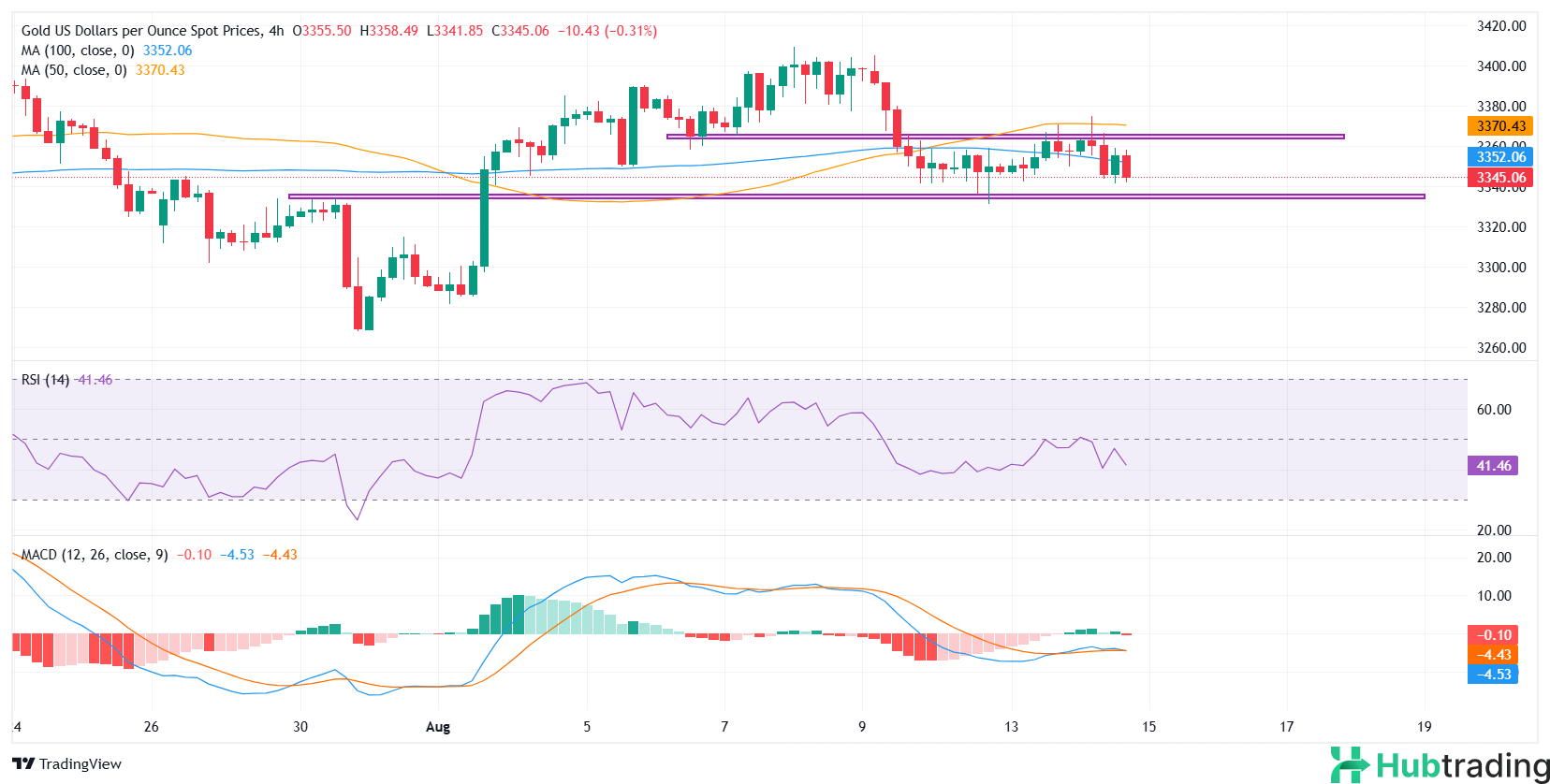-
Gold prices edge lower to $3,335 amid renewed strength in the US Dollar, limiting upside momentum.
-
Market sentiment remains cautious ahead of the US-Russia summit in Alaska on Friday, as former President Donald Trump warns of “very severe” consequences if Russia fails to end the war in Ukraine.
-
US Producer Price Index (PPI) data for July came in hotter than expected, with both headline and core inflation rising sharply, reinforcing inflation concerns and supporting the Greenback.
Gold (XAU/USD) eased lower on Thursday, trading within a familiar range as renewed strength in the US Dollar capped gains. The move followed stronger-than-expected Producer Price Index (PPI) and steady Weekly Jobless Claims data, which tempered dovish bets on Federal Reserve rate cuts.
As of writing, gold is trading around $3,337 in the US session, down 0.50% on the day, after earlier hitting an intraday high of $3,374.88 during the Asian session.
July’s PPI jumped by 0.9% month-over-month (MoM), sharply higher than the 0.2% forecast and June’s flat reading, marking the biggest monthly gain since June 2022. On a yearly basis, PPI accelerated to 3.3% from 2.4%, beating the 2.5% consensus.
Core PPI, which strips out food and energy prices, mirrored the headline figure, rising 0.9% MoM (vs. 0.2% expected), with the annual rate climbing to 3.7% from 2.6%, surpassing the 2.9% estimate.
The data bolstered the US Dollar as traders reassessed the likelihood of aggressive rate cuts later this year.
Caution dominated sentiment ahead of Friday’s high-stakes US-Russia summit in Alaska. Former President Donald Trump warned of "very severe" consequences if Russia fails to end its war in Ukraine, telling reporters at the Kennedy Centre that retaliatory action could follow the talks with President Vladimir Putin, according to CNN.
While some investors view the summit as an opportunity for diplomatic progress, others fear a breakdown in dialogue could spark renewed geopolitical instability — a potential driver of safe-haven demand for gold.
Market Movers: Dollar Recovers, Yields Steady
- The US Dollar Index (DXY), which tracks the greenback against a basket of six major currencies, rebounded above the 98.00 mark on Thursday, recovering from a two-week low after the upbeat economic data.
- US Treasury yields were broadly stable, with the 10-year note hovering around 4.265% and the 30-year yield near 4.845%, as investors weighed hot inflation prints against expectations for Fed easing.
- Fed funds futures now fully price in a 25 basis point cut at the September FOMC meeting, according to the CME FedWatch Tool — a sharp rise from just 60% odds a few weeks ago. The market also sees a 66% probability of another cut in October and a 54.5% chance of a further move in December.
- US Treasury Secretary Scott Bessent reiterated his view on Wednesday that interest rates should be 150–175 basis points lower, calling for an aggressive 50 bps cut in September due to slowing inflation and labor market softness.
- Chicago Fed President Austan Goolsbee stressed that upcoming policy meetings remain “live,” warning that tariffs could deliver a “stagflationary shock.” He noted persistent services inflation and flagged labor market tightness, though he added that slower job gains may reflect structural shifts like population changes.
- Meanwhile, Atlanta Fed’s Raphael Bostic maintained his cautious tone, saying the Fed has “the luxury” to wait, thanks to resilient labor data. He still sees only one rate cut in 2025 as appropriate.
Technical Analysis: XAU/USD Rangebound Between $3,340 and $3,370
On the 4-hour chart, gold continues to consolidate within the $3,340–$3,370 zone. The 100-period SMA near $3,352 offers minor support, while the 50-period SMA around $3,370 acts as immediate resistance.

Price action shows dip-buying interest, as reflected in repeated lower shadows on recent candles. However, bulls have yet to push beyond $3,370, leaving the near-term bias neutral until a breakout occurs.
-
Resistance to watch: A sustained move above $3,370 could open the door to a test of the $3,400 psychological barrier.
-
Support levels: On the downside, a break below $3,340 may expose the $3,300 handle.
Momentum indicators are mixed. The Relative Strength Index (RSI) sits near 46, suggesting mild bearish pressure without strong conviction. The MACD histogram is flattening after a bearish phase, with the signal line still slightly above the MACD line, indicating a potential shift in momentum.





